Tarantulas are commonly feared by humans, and their relatively large size gives the impression that tarantulas must be feared by other arthropods as well. Of course,

surviving as an arthropod is a matter that is far more complicated than mere body size. For example, some of the deadliest arthropod predators are small parasitic organisms, and some of the least successful arthropod species are large lumbering tarantulas. This claim is well backed-up by the peculiar relationship between tarantulas and their wasp predators, which are commonly known as digger wasps. Digger wasps are also referred to as “tarantula hawk moths,” and they are known for inflicting the most painful stings of any arthropod species. The Pepsis marginata species of tarantula hawk moth is native to Puerto Rico, and it is specialized to hunt and kill the Cyrtopholis portoricae species of tarantula in a particularly brutal manner, even for a tarantula hawk moth.
The Pepsis marginata wasp species has evolved to use its eyesight to seek out the nesting burrows belonging to the common Cyrtopholis portoricae tarantula species. When these two arthropods are being studied in captivity, the Pepsis marginata locates its tarantula prey with the sense of touch. These fierce wasps only attack tarantulas for the purpose of laying an egg within their carcasesses, which provides a full meal for the wasp larvae once it hatches. Therefore, these wasps only attack tarantulas when they are ready to lay an egg.
Tarantula hawk moths have been documented digging graves for their tarantula victims, and sometimes a wasp will dig a grave even before it secures a tarantula victim. The wasp captures its prey by first using its jaws to grip the tarantula’s leg in order to hold it in place while delivering its paralyzing sting. Tarantulas, despite their superior size, are nearly defenseless against these wasp attacks. The only way a tarantula can dodge a predatory wasp attack is by quickly moving to the lowest area of their nesting burrow where wasps cannot reach. After the wasp inflicts its venomous sting, it consumes the blood and innards that drain out of the tarantula’s gaping sting-wound. The wasp then buries the paralyzed and badly wounded tarantula in a shallow grave after laying an egg on its body. The egg eventually hatches wasp larvae, which immediately consumes the tarantula’s remains as a nutritious meal to kick-start its growth into adulthood. According to experts, the tarantula’s prey does not die after being wounded and buried. Despite the heart-stopping effect of the wasp venom, the tarantula eventually recovers, but cannot escape from the tightly packed grave-soil. In other words, the tarantula hawk moth buries tarantulas alive after torturing them, and before their offspring eats them alive.
Have you ever witnessed one small arthropod winning a fight against a larger arthropod?











